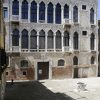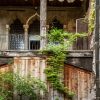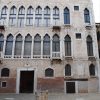The precise date of construction of Palazzo Pesaro cannot be documented, and the archive searches carried out have not yielded any reliable results yet. The stylistic study and the comparison with other Venetian palaces suggest the start of construction between 1460 and 1480. Commissioned by Benedetto Pesaro (1433-1503) – Venetian nobleman holding the role of commander in chief of the Venetian navy from 1500 to 1503, and known for his military successes during the Second Ottoman-Venetian War – the building, enlarged and transformed over the centuries, shows the grandeur of its vast bulk with a façade facing Rio di Ca’ Michiel and a larger one on Campo San Beneto. The building, whose architectural structure fully responds to Venetian tradition, boasts some solutions of considerable value, such as the four multi-light windows on the first and second noble floors, and an unusual depth of the rooms between the two façades, over 43 meters in length, which make this building the largest private construction of the Venetian late Gothic Renaissance.
The palace stands on an area that in the 12th century was occupied by a building of worship officiated by Cistercian monks, while in the following century it housed a building with the characteristics of a fondaco, a home and warehouse. Originally, Palazzo Pesaro had an L-shaped plant, but after 1500 two narrow buildings, still existing, were built towards Calle degli Orfei. Mentioned among the main palaces of the city by Francesco Sansovino in his book Venetia città nobilissima et singolare (1581), on the death of Benedetto Pesaro it was inherited by his son Gerolamo, who in his will imposed “neither to sell, nor to pledge, only to keep and, at most, divide into two houses, one on the first and one on the second noble floor.” Towards the end of the 17th century, the male lineage of the Pesaro di San Beneto family died out and the property was divided into two parts: Elena Pesaro, the last direct heir, was the main beneficiary. From 1720 to about 1825, the building was entirely rented out: it hosted, among others, the Albrizzi Typography, but also musical societies such as the Accademia degli Orfei from 1786. In the following years, between 1834 and 1860, another musical association, the Società Apollinea, found its headquarters within the walls of the building, to later move to the Teatro La Fenice. In the mid-nineteenth century the building, as shown in the Austrian land registry of 1842, was divided into numerous apartments owned by the Campana, Correr, Revedin families, with the subsequent creation of new vertical and horizontal connections, to accommodate about twenty residential units and allocate some spaces for commercial use, such as the printing workshops of one of the most famous Venetian photographers of the time, Paolo Salviati.
When Mariano Fortuny y Madrazo, attracted by this architectural beauty, entered it for the first time in 1898, occupying the large hall located in the attic and establishing his own studio, it was in a state of decay. Over the years, having acquired the other parts of the building in 1899, 1900 and 1906, Fortuny, patiently but steadily, began the restoration work of the building: as people left, he freed the apartments, readjusted the rooms, and dropped partitions and superstructures, thus restoring balance and proportion.
Between the walls of the large hall on the top floor, after a first use dedicated to his artistic and scenographic experiments, Fortuny conceived and built the first plaster model of the famous theatrical device called “Cupola”. He then chose the palace as his home and in 1907 he installed a small textile workshop there together with Henriette Nigrin, known in Paris at the beginning of the twentieth century, inspiring muse and companion of equal artistic sensitivity. After a few years, two entire floors of the building were occupied by the extraordinary atelier for the creation and printing of dresses and silk and velvet fabrics. While Mariano was perfecting his studies and his inventions, his wife Henriette, with exceptional dedication, directed the laboratory. Interesting photographs are the witnesses of this change: in the hall in the attic, samples of raw fabrics, containers and glass jars with raw materials lie on the work tables; tables where, in another photograph, Henriette is immortalized by Mariano’s camera as she prepares to spread the colour on a wooden matrix.
Palazzo Pesaro degli Orfei soon became a factory. Every morning, when the caretaker opened the door, workers entered the small courtyard and, climbing the open staircase, arranged themselves in the hall of the atelier, some at the printing frames, others at the finishing of garments. Since 1915 Mariano began the wall decoration of one of the building’s magical places: the winter garden and painting studio located on the first noble floor. An “enchanted garden”, animated by female figures, allegorical images, satyrs and exotic animals, parrots, monkeys, framed in an original architectural context, enveloped in floral and vegetable motifs, garlands and grotesques. On the second floor he accommodated the precious library, full of valuable books, drawing inspiration from the memory of his father’s artist studio and his personal artistic experience. He furnished the interiors of the living room on the first floor with rich seductive gleams of the East, merging the idea of the paternal artist’s studio and the aesthetic enhancement of his work with printed fabrics of his own production on the walls, silk chandeliers, armours, antique carpets and furniture (now partially dispersed). From the 1920s onwards, in this atmosphere permeated by an evocative oriental splendour with Renaissance reminiscences, in the halls and bare rooms used as atelier, laboratory, and workshop, Mariano incessantly continued his work dedicating himself to the search for new solutions for theatrical scenes, to the creation of patterns for printed fabrics, to the invention of new styles for clothing, never forgetting his great passion: painting. Those who, enjoying a rare privilege, managed to cross the threshold of those halls could only bring back an ecstatic vision. Rare, if not unique, because usually the door was always closed; in fact, to avoid the hassle of unwanted visits, the keeper had the order to say: “The Master works”.
After Fortuny’s death on May 2, 1949, the building was donated by his wife Henriette to the Municipality of Venice in 1956 to be “used perpetually as a centre of culture in relation to art; the central hall on the first floor will have to preserve the characteristics of what was the favourite studio of Mariano Fortuny y Madrazo, with the works, furniture and objects currently found there; the property must be called Palazzo Pesaro Fortuny”, as expressly indicated in the notarial deed. The city administration actually took full possession of it in 1965, when Henriette died. Ten years later, in 1975, the Museum finally opened to the public. In 1978 the Venetian administration completed the property by purchasing the Androne on the ground floor, finally granting integrity to the entire complex that has now become a museum.
Downloads
![]() ENG / Mariano Fortuny and his Palace
ENG / Mariano Fortuny and his Palace
(PDF 1345 Kb) – short version
The history, the building, collections and general information >






